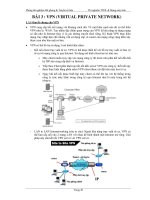Tài liệu Virtual Private Network (VPN) Implementation Options pptx
Bạn đang xem bản rút gọn của tài liệu. Xem và tải ngay bản đầy đủ của tài liệu tại đây (560.05 KB, 32 trang )
This chapter includes the following topics:
•
Virtual Private Network Evolution
•
Business Problem-based VPN Classification
•
Overlay and Peer-to-peer VPN Mode
•
Typical VPN Network Topologies
CH08 Page 128 Wednesday, February 19, 2003 4:23 PM
C
H
A
P
T
E
R
8
Virtual Private Network (VPN)
Implementation Options
A Virtual Private Network (VPN) is defined loosely as a network in which customer
connectivity among multiple sites is deployed on a shared infrastructure with the same
access or security policies as a private network. With the recent advent of marketing
activities surrounding the term VPNs, from new technologies supporting VPNs to a flurry
of VPN-enabled products and services, you might think that the VPN concept is a major
technology throughput. However, as is often the case, VPN is a concept that is more than
10-years old and is well known in the service provider market space.
The new technologies and products merely enable more reliable, scalable, and more cost-
effective implementation of the same product. With the cost reduction and enhanced
scalability associated with new VPN technologies, it’s not surprising that VPN services are
among the major drivers for Multiprotocol Label Switching (MPLS) deployment in service
provider and enterprise networks.
Before discussing a technology (VPN services based on MPLS) designed to solve a
problem (cost-effective VPN implementation), it’s always advantageous to focus on the
problem first, which is what we do in this chapter.
This chapter gives you an overview of VPN services, common VPN terminology, and
detailed classification of various VPN usages and topologies that are encountered most
often. This chapter also provides an overview of technologies that were used traditionally
to implement Virtual Private Networks either on individual service provider backbones or
over the public Internet.
Virtual Private Network Evolution
Initial computer networks were implemented with two major technologies:
leased lines
for
permanent connectivity and
dial-up lines
for occasional connectivity requirements. Figure
8-1 shows a typical network from those days.
CH08 Page 129 Wednesday, February 19, 2003 4:23 PM
130
Chapter 8: Virtual Private Network (VPN) Implementation Options
Figure 8-1
Typical Computer Network from 15 Years Ago
The initial computer network implementation provided the customers with good security
(capturing data off leased lines requires dedicated equipment and physical access to the
wires) but did not provide cost-effective implementation due to two reasons:
•
The typical traffic profile between any two sites in a network varies based on the time
of day, the day of the month, and even the season. (For example, traffic at retail stores
increases around Christmas season.)
•
The end-users always request fast responses, resulting in a high bandwidth
requirement between sites, but the dedicated bandwidth available on the leased lines
is used only part of the time (when the users are active).
These two reasons prompted the data communication industry and service providers to
develop and implement a number of statistical multiplexing schemas that provided the
customers with a service that was almost an equivalent to leased lines. This service was
cheaper, however, due to the statistical benefits the service provider could achieve from a
large customer base. The first
virtual
private networks were based on such technologies as
X.25 and Frame Relay, and, later, SMDS and ATM. Figure 8-2 shows a typical VPN built
with these technologies (for example, Frame Relay).
As you can see in Figure 8-2, the overall VPN solution has a number of components:
•
The service provider is the organization that owns the infrastructure (the equipment
and the transmission media) that provides emulated leased lines to its customers. The
service provider in this scenario offers a customer a
Virtual Private Network Service
.
IBM mainframe and front-end Processor (SNA router)
Cluster controllers (SNA end hosts)
Leased lines
CH08 Page 130 Wednesday, February 19, 2003 4:23 PM
Virtual Private Network Evolution
131
Figure 8-2
Typical Frame Relay Network
•
The customer connects to the service provider network through a
Customer Premises
Equipment (CPE)
device. The CPE is usually a Packet Assembly and Disassembly
(PAD) device that provides plain terminal connectivity, a bridge, or a router. The CPE
device is also sometimes called a
Customer Edge (CE)
device.
•
The CPE device is connected through transmission media (usually a leased line, but
could also be a dial-up connection) to the service provider equipment, which could be
an X.25, Frame Relay, or ATM switch, or even an IP router. The edge service provider
device is sometimes called the
Provider Edge (PE)
device.
•
The service provider usually has additional equipment in the core of the service
provider network (also called the
P network
). These devices are called
P devices
(for
example, P switches or P routers).
•
A contiguous part of the customer network is called a
site
. A site can connect to the
P network through one or several transmission lines, using one or several CPE and PE
devices, based on the redundancy requirements.
•
The emulated leased line provided to the customer by the service provider in the
overlay VPN model (see the section, “Overlay and Peer-to-peer VPN Model,” later in
this chapter for more details) frequently is called a
Virtual Circuit (VC)
. The VC can
be either constantly available (
Permanent Virtual Circuit [PVC]
) or established on
demand (
Switched Virtual Circuit [SVC]
). Some technologies used special terms for
VCs, for example Data Link Connection Identifier (DLCI) in Frame Relay.
•
The service provider can charge either a flat rate for the VPN service, which normally
depends on the bandwidth available to the customer, or a usage-based rate, which can
depend on the volume of data exchanged or the duration of data exchange.
Customer site
Service provider network
Customer Premises
Equipment (CPE)
Provider edge device
(Frame Relay switch)
Provider core device
VC #2
VC #1
PE-device
PE-device
CPE router
CPE router Other customer
routers
Large
customer
site
CH08 Page 131 Wednesday, February 19, 2003 4:23 PM
132
Chapter 8: Virtual Private Network (VPN) Implementation Options
Modern Virtual Private Networks
With the introduction of new technologies in the service provider networks and new
customer requirements, the VPN concept became more and more complex. Vendors
introduced different and often conflicting terms, which further increased the complexity.
The modern VPN services thus can span a variety of technologies and topologies. The only
way to cope with this diversity is to introduce VPN classification, which you can do using
four criteria:
•
The business problem a VPN is trying to solve. The major classes of business
problems are intracompany communication (lately, also called
intranet
), inter-
company communication (also called
extranet
), and access for mobile users (also
called
Virtual Private Dialup Network
).
•
The OSI layer at which the service provider exchanges the topology information with
the customer. Major categories here are the
overlay model
, where the service provider
provides the customer with only a set of point-to-point (or multipoint) links between
the customer sites, and the
peer model
, where the service provider and the customer
exchange Layer 3 routing information.
•
The Layer 2 or Layer 3 technology used to implement the VPN service within the
service provider network, which can be X.25, Frame Relay, SMDS, ATM, or IP.
•
The topology of the network, which can range from simple hub-and-spoke topology
to fully meshed networks and multilevel hierarchical topologies in larger networks.
Business Problem-based VPN Classification
The three business problems a typical organization is trying to solve with a Virtual Private
Network are
•
Intra-organizational communication (intranet)
•
Communication with other organizations (extranet)
•
Access of mobile users, home workers, remote office, and so on, through inexpensive
dial-up media (Virtual Private Dial-up Network)
The three types of VPN solutions usually span most of the topologies and technologies
offered by VPN service providers, but differ greatly in the level of security required in their
implementation.
Intra-organizational communications usually are not protected well by the end hosts or
the firewalls. The VPN service used to implement intra-organizational communication
therefore must offer high levels of isolation and security. Intra-organizational
communications also require guaranteed quality of service for mission-critical processes.
CH08 Page 132 Wednesday, February 19, 2003 4:23 PM
Business Problem-based VPN Classification
133
These are the two major reasons why we don’t see many organizations using the Internet,
which cannot offer end-to-end quality of service, isolation, or security, as the infrastructure
for their intra-organizational communications. Intranet VPNs were thus usually
implemented with traditional technologies like X.25, Frame Relay, or ATM.
Inter-organizational communications frequently take place between central sites of the
organizations—usually using dedicated security devices, such as firewalls or encryption
gear similar to the setup demonstrated in Figure 8-3. These communications also might
have less stringent quality of service requirements. This set of requirements makes the
Internet more and more suitable for inter-organizational communications; therefore, it’s no
surprise that more and more business-to-business traffic takes place over the Internet.
Figure 8-3
Typical Extranet Setup
Remote user access into a corporate network, typically from changing or unknown
locations, is always riddled with security issues, which have to be resolved on an end-to-
end basis using such technologies as encryption or one-time passwords. Thus, the security
requirements for VPDN services were never as high as the requirements for Intranet
communications. It’s no surprise that most of the VPDN services today are implemented on
top of Internet Protocol (IP), either over the Internet or using the private backbone of a
service provider, as illustrated in Figure 8-4. The protocols used to implement VPDN
service over IP include Layer 2 Forwarding (L2F) or Layer 2 Transport Protocol (L2TP).
Organization #1
Organization #3
Firewall
Organization #2
Firewall
Public Internet
Encrypted point-to-point
tunnels (IPSec)
CH08 Page 133 Wednesday, February 19, 2003 4:23 PM
134
Chapter 8: Virtual Private Network (VPN) Implementation Options
Figure 8-4
Service Provider Offering Separate VPDN Backbone
The VPDN technology uses a number of special terms that are unique to the VPDN world:
•
Network Access Server
(
NAS
)—The Remote Access Server (RAS) managed by the
service provider that accepts the customer call, performs the initial authentication, and
forwards the call (through L2F or L2TP) to the customer’s gateway.
•
Home Gateway
—A customer-managed router that accepts the call forwarded by the
NAS, performs additional authentication and authorization, and terminates the PPP
session from the dial-up user. The PPP session parameters (including network
addresses, such as an IP address) are negotiated between the dial-up user and the
home gateway; NAS only forwards frames of Point-to-Point Protocol (PPP) between
the two.
NOTE
The details of VPDN, L2F, and L2TP are beyond the scope of this book. Please refer to
Access VPDN Solutions Guide
from Cisco Press for additional information on these topics.
You might also want to refer to
RFC 2341 Cisco Layer Two Forwarding (Protocol) “L2F”
and
RFC 2661 Layer Two Tunneling Protocol “L2TP”
for in-depth information.
Organization with
remote offices or
dial-up users
Home Gateway
Private Service Provider IP backbone
VPDN tunnel (L2F
or L2TP)
Network Access
Server (NAS)
Service Provider
Point-of-Presence (POP)
Remote
user
Dial-up network
(for example, ISDN)
Virtual dial-up connection (PPP frames
encapsulated in L2F or L2TP packets)
CH08 Page 134 Wednesday, February 19, 2003 4:23 PM
Overlay and Peer-to-peer VPN Model
135
Overlay and Peer-to-peer VPN Model
Two VPN implementation models have gained widespread use:
•
The overlay model, where the service provider provides emulated leased lines to the
customer.
•
The peer-to-peer model, where the service provider and the customer exchange
Layer 3 routing information and the provider relays the data between the customer
sites on the optimum path between the sites and without the customer’s involvement.
NOTE
One might argue that the case where the customer and the provider use the same Layer 2
technology (for example, Frame Relay or ATM switches) also constitutes a peer-to-peer
model, but because we focus on Layer 3 VPN services here, we will not consider this
scenario. Similarly, a humorous person might call a leased line service a Layer 1 peer-to-
peer model.
Overlay VPN Model
The overlay VPN model is the easiest to understand because it provides very clear
separation between the customer’s and the service provider’s responsibilities:
•
The service provider provides the customer with a set of emulated leased lines. These
leased lines are called VCs, which can be either constantly available (PVCs) or
established on demand (SVCs). Figure 8-5 shows the topology of a sample overlay
VPN and the VCs used in it.
CH08 Page 135 Wednesday, February 19, 2003 4:23 PM
136
Chapter 8: Virtual Private Network (VPN) Implementation Options
Figure 8-5
Sample Overlay VPN Network
•
The customer establishes router-to-router communication between the Customer
Premises Equipment (CPE) devices over the VCs provisioned by the service provider.
The routing protocol data is always exchanged between the customer devices, and the
service provider has no knowledge of the internal structure of the customer network.
Figure 8-6 shows the routing topology of the VPN network in Figure 8-5.
Figure 8-6
Routing in Sample Overlay VPN Network
The QoS guarantees in the overlay VPN model usually are expressed in terms of bandwidth
guaranteed on a certain VC (Committed Information Rate or CIR) and maximum
bandwidth available on a certain VC (Peak Information Rate or PIR). The committed
bandwidth guarantee usually is provided through the statistical nature of the Layer 2 service
but depends on the overbooking strategy of the service provider. This means that the
committed rate is not actually guaranteed although the provider can provision a Minimum
Information Rate (MIR) that effectively is nailed up across the Layer 2 infrastructure.
Customer site
Service provider network
Alpha
PE-device
(Frame Relay switch)
VC #2
VC #1
Frame Relay
Edge switch
Customer site
Gamma
Frame Relay
Edge switch
Beta
Customer site
Alpha
Gamma
Beta
CH08 Page 136 Wednesday, February 19, 2003 4:23 PM
Overlay and Peer-to-peer VPN Model
137
NOTE
The committed bandwidth guarantee is also only a guarantee of the bandwidth between two
points in the customer network. Without a full traffic matrix for all traffic classes, it’s hard
for the customer to engineer guarantees in most overlay networks. It’s also hard to provide
multiple classes of service because the service provider cannot differentiate the traffic in the
middle of the network. Working around this by creating multiple connections (for example,
Frame Relay PVCs) between the customer sites only increases the overall cost of the
network.
Overlay VPN networks can be implemented with a number of switched WAN Layer 2
technologies, including X.25, Frame Relay, ATM, or SMDS. In the last years, overlay VPN
networks also have been implemented with IP-over-IP tunneling, both in private IP
backbones and over the public Internet. The two most commonly used IP-over-IP tunneling
methods are Generic Route Encapsulation (GRE) tunneling and IP Security (IPSec)
encryption.
NOTE
This book does not discuss the various Layer 2 and Layer 3 overlay VPN technologies in
detail because they are covered well in other Cisco Press publications and are beyond the
scope of this book. For more information on Layer 2 WAN technologies, please refer
to
Internetworking Technologies Handbook
, Second Edition
,
from Cisco Press (ISBN
1-57870-102-3). For a description of IP-over-IP tunneling and IPSec encryption, please see
RFC 1702 – Generic Routing Encapsulation over IPv4 networks
,
RFC 2401 – Security
Architecture for the Internet Protocol
,
and
Enhanced IP Services for Cisco Networks
from
Cisco Press (ISBN 1-57870-106-6).
Although it’s relatively easy to understand and implement, the overlay VPN model
nevertheless has a number of drawbacks:
•
It’s well suited to non-redundant configurations with a few central sites and many
remote sites, but becomes exceedingly hard to manage in a more meshed
configuration (see also the section, “Typical VPN Network Topologies,” later
in this chapter for more details).
•
Proper provisioning of the VC capacities requires detailed knowledge of site-to-site
traffic profiles, which are usually not readily available.
•
The implementation cost grows linearly with the number of point-to-point
connections provisioned in the network, not with the number of networked sites.
Last but not least, the overlay VPN model, when implemented with Layer 2 technologies,
introduces another unnecessary layer of complexity into the New World Service Provider
CH08 Page 137 Wednesday, February 19, 2003 4:23 PM
138
Chapter 8: Virtual Private Network (VPN) Implementation Options
networks that are mostly IP-based, thus increasing the acquisition and operational costs of
such a network.
Peer-to-peer VPN Model
The peer-to-peer VPN model was introduced a few years ago to alleviate the drawbacks of
the overlay VPN model. In the peer-to-peer model, the Provider Edge (PE) device is a router
(PE router) that directly exchanges routing information with the CPE router. Figure 8-7
shows a sample peer-to-peer VPN, which is equivalent to the VPN in Figure 8-5.
NOTE The Managed Network service offered by many service providers, where the service
provider also manages the CPE devices, is not relevant to this discussion because it’s only
a repackaging of another service. The Managed Network provider concurrently assumes
the role of the VPN service provider (providing the VPN infrastructure) and part of the VPN
customer role (managing the CPE device).
Figure 8-7 Sample Peer-to-peer VPN
Customer site
Service provider network
Alpha
PE router
Customer site
Gamma
Beta
Customer site
PE router
PE router
Routing information is
exchanged between customer
and service provider routers.
Service provider routers
exchange customer routes
through the core network.
Finally, the customer routes propagated
through the service provider network
are sent to other customer routers.
CH08 Page 138 Wednesday, February 19, 2003 4:23 PM
Overlay and Peer-to-peer VPN Model 139
NOTE Please note that this section describes the non-MPLS approach to peer-to-peer VPN as
currently deployed by several large service providers and the complexities associated with
it. The MPLS-based peer-to-peer VPN approach is described in the next chapter.
The peer-to-peer model provides a number of advantages over the traditional overlay
model:
• Routing (from the customer’s perspective) becomes exceedingly simple, as the
customer router exchanges routing information with only one (or a few) PE router,
whereas in the overlay VPN network, the number of neighbor routers can grow to a
large number.
• Routing between the customer sites is always optimal, as the provider routers know
the customer’s network topology and can thus establish optimum inter-site routing.
• Bandwidth provisioning is simpler because the customer has to specify only the
inbound and outbound bandwidths for each site (Committed Access Rate [CAR] and
Committed Delivery Rate [CDR]) and not the exact site-to-site traffic profile.
• The addition of a new site is simpler because the service provider provisions only an
additional site and changes the configuration on the attached PE router. Under the
overlay VPN model, the service provider must provision a whole set of VCs leading
from that site to other sites of the customer VPN.
Prior to an MPLS-based VPN implementation, two implementation options existed for the
peer-to-peer VPN model:
• The shared-router approach, where several VPN customers share the same PE router.
• The dedicated-router approach, where each VPN customer has dedicated PE routers.
Shared-router Approach to Peer-to-peer VPN Model
In the shared-router approach, several customers can be connected to the same PE router.
Access lists have to be configured on every PE-to-CE interface on the PE router to ensure
isolation between VPN customers, to prevent a VPN customer from breaking into another
VPN network, or to prevent a VPN customer from performing a denial-of-service attack on
another VPN customer. Figure 8-8 illustrates a sample shared-router configuration.
CH08 Page 139 Wednesday, February 19, 2003 4:23 PM
140 Chapter 8: Virtual Private Network (VPN) Implementation Options
Figure 8-8 Peer-to-peer VPN Model: Shared Router Configuration
Let’s assume that the customers shown in Figure 8-8 use the address space and routing
protocols from Table 8-1.
To ensure the isolation between the customers, the configuration from Example 8-1 would
have to be entered in the POP-router in Figure 8-8.
Table 8-1 Peer-to-peer Shared-router Example—Address Space
Customer Name Address Space Routing Protocol
FriedFoods (Customer #75) 155.13.0.0/16 RIP
GeneralMining (Customer #98) 195.166.16.0/20 OSPF (area 3)
Example 8-1 POP-router Configuration
interface serial 0/0/1
description FriedFoods – San Jose Site
ip address 155.13.254.1 255.255.255.252
! The IP address on WAN link is an address from Customer’s address space
ip access-group FriedFoods in
ip access-group FriedFoods out
!
interface serial 0/0/2
description FriedFoods – Santa Clara Site
ip address 155.13.254.5 255.255.255.252
ip access-group FriedFoods in
ip access-group FriedFoods out
!
interface serial 0/1/3
description GeneralMining – Mountain View Site
Service provider networkFried Foods
San Jose
Fried Foods
San Jose
Silicon Valley POP
Shared router
The shared PE router contains
all customer routes.
GeneralMining
Mountain View
CH08 Page 140 Wednesday, February 19, 2003 4:23 PM
Overlay and Peer-to-peer VPN Model 141
Dedicated-router Approach to Peer-to-peer Model
In the dedicated-router approach to the peer-to-peer model, every VPN customer has their
own dedicated PE routers (as detailed in Figure 8-9) and, thus, has access only to the routes
contained within the routing table of that PE router.
Figure 8-9 Peer-to-peer VPN Model: Dedicated Router Configuration
The dedicated-router model uses routing protocols to create per-VPN routing tables on PE
routers. The routing tables on PE routers contain only the routes advertised by the VPN
customer connected to them, resulting in almost perfect isolation between the VPN
ip address 195.166.31.17 255.255.255.252
ip access-group GeneralMining in
ip access-group GeneralMining out
!
router rip
network 155.13.0.0
!
router ospf 1
network 195.166.31.17 0.0.0.0 area 3
!
ip access-list FriedFoods
permit ip 155.13.0.0 0.0.255.255 155.13.0.0 0.0.255.255
!
ip access-list GeneralMining
permit ip 195.166.16.0 0.0.15.255 195.166.16.0 0.015.255
Example 8-1 POP-router Configuration (Continued)
Service provider networkFried Foods
San Jose
Fried Foods
San Jose
GeneralMining
Mountain View
Silicon Valley POP
PE router
FriedFoods
PE router
GeneralMining
P router
SiliconValley
Uplink
The P router contains all routes
from all VPN customers.
The dedicated PE router
contains only routes from its
customer sites.
CH08 Page 141 Wednesday, February 19, 2003 4:23 PM
142 Chapter 8: Virtual Private Network (VPN) Implementation Options
customers (assuming that the IP source routing is disabled). The routing in the dedicated-
router model can be implemented as follows:
• Any routing protocol is run between the PE router and the CE router.
• BGP is run between the PE router and the P router.
• The PE router redistributes routes received from the CE router into BGP, marked with
the customer ID (BGP community), and propagates the routes to the P routers.
P-routers thus contain all the routes from all VPN customers.
• P-routers propagate only routes with the proper BGP community to the PE routers.
The PE routers thus receive only the routes that originated from the CE routers in their
VPN.
Relevant parts of PE router and P router configuration for the Service Provider Point-of-
Presence (POP) shown in Figure 8-9 (assuming the address space and the routing protocols
from Table 8-1) can be found in Example 8-2 and Example 8-3.
Example 8-2 PE Router Configuration
hostname PE-router-FriedFoods
!
interface serial 0/0/1
description FriedFoods – San Jose Site
ip address 155.13.254.1 255.255.255.252
!
interface serial 0/0/2
description FriedFoods – Santa Clara Site
ip address 155.13.254.5 255.255.255.252
!
interface FastEthernet 2/0/0
description Intra-POP LAN
ip address 10.13.1.2 255.255.255.0
!
router rip
network 155.13.254.1
version 2
redistribute bgp 111 subnets
!
router bgp 111
no auto-summary
redistribute rip route-map ToBGP-FriedFoods
neighbor 10.13.1.1 remote-as 111
!
route-map ToBGP-FriedFoods permit 10
set community 111:75
Example 8-3 P Router Configuration
hostname P-Router-Silicon-Valley-POP
!
interface FastEthernet 0/1/0
CH08 Page 142 Wednesday, February 19, 2003 4:23 PM
Typical VPN Network Topologies 143
Comparison of Peer-to-peer Models
As you easily can deduce from Example 8-1, the shared-router peer-to-peer model is very
hard to maintain because it requires the deployment of potentially long and complex access
lists on almost every router interface. The dedicated-router approach, although simpler to
configure and maintain, becomes very expensive for the service provider when it tries to
serve a large number of customers with geographically dispersed sites.
Both peer-to-peer models also share several common drawbacks that prevent their
widespread usage:
• All the customers share the same IP address space, preventing the customers from
deploying private IP addresses according to RFC 1918. The customers must use either
public IP addresses or private IP addresses allocated to them by the service provider.
• The customers cannot insert the default route into their VPN. This limitation prevents
certain routing optimizations and prevents the customers from getting Internet access
from another service provider.
In addition to these two drawbacks, the shared-router model suffers from additional
complexity when several customers use the routing protocols (RIP, RIPv2, BGP, and IS-IS)
where multiple instances are not supported in Cisco IOS.
Typical VPN Network Topologies
The VPN topology required by an organization should be dictated by the business problems
the organization is trying to solve. However, several well-known topologies appear so often
that they deserve to be discussed here. As you can see, the same topologies solve a variety
of different business issues in different vertical markets or industries.
The VPN topologies discussed here can be split into three major categories:
• Topologies influenced by the overlay VPN model, which include hub-and-spoke
topology, partial or full-mesh topology, and hybrid topology.
description Intra-POP LAN
ip address 10.13.1.1 255.255.255.0
!
router bgp 111
neighbor 10.13.1.2 remote-as 111
neighbor 10.13.1.2 route-reflector-client
neighbor 10.13.1.2 route-map VPN-FriedFoods out
!
route-map VPN-FriedFoods permit 10
match community-list 75
!
ip community-list 75 permit 111:75
Example 8-3 P Router Configuration
CH08 Page 143 Wednesday, February 19, 2003 4:23 PM
144 Chapter 8: Virtual Private Network (VPN) Implementation Options
• Extranet topologies, which include any-to-any Extranet and Central Services
Extranet.
• Special-purpose topologies, such as VPDN backbone and Managed Network
topology.
Hub-and-spoke Topology
The most commonly encountered topology is a hub-and-spoke topology, where a number
of remote offices (spokes) are connected to a central site (hub), similar to the setup in
Figure 8-10. The remote offices usually can exchange data (there are no explicit security
restrictions on inter-office traffic), but the amount of data exchanged between them is
negligible. The hub-and-spoke topology is used typically in organizations with strict
hierarchical structures, for example, banks, governments, retail stores, international
organizations with small in-country offices, and so on.
NOTE When deploying VPNs based on Layer 2 technologies, such as Frame Relay or ATM, the
hub-and-spoke VPN topology is more common than you might expect. This is based purely
on business needs due to higher costs or increased routing complexity associated with other
topologies that use these types of technologies. In other words, there are many examples
where the customer could benefit from a different topology but has nonetheless chosen the
hub-and-spoke topology for cost or complexity reasons.
With increased redundancy requirements, the simple hub-and-spoke topology from
Figure 8-10 often is enhanced with an additional router at the central site (shown in Figure
8-11) or with a backup central site, which is then linked with the primary central site
through a higher-speed connection (shown in Figure 8-12).
CH08 Page 144 Wednesday, February 19, 2003 4:23 PM
Typical VPN Network Topologies 145
Figure 8-10 Hub-and-spoke Topology
Figure 8-11 Hub-and-spoke Topology with Two Central Routers
Implementing redundant hub-and-spoke topology with an overlay VC–based VPN model
always poses a number of challenges. Each spoke site requires a VC to at least two central
routers. These VCs could be provisioned in primary-backup configuration or in load-
sharing configuration with a number of drawbacks of one or the other solution:
• In primary-backup configuration, the backup VC is unused while the primary VC is
active, resulting in unnecessary expenses incurred by the customer.
• In load-sharing configuration, the spoke site encounters reduced throughput if one of the
VCs (or one of the central routers) fails. The load-sharing configuration is also not
appropriate for the topologies with a backup central site similar to the one in Figure 8-12.
Central site (hub)
Service provider network
Remote site (spoke)
Remote site (spoke)
Remote site (spoke)
Central site router
Central site (hub)
Service provider network
Remote site (spoke)
Remote site (spoke)
Remote site (spoke)
Redundant central
site router
Redundant central
site router
CH08 Page 145 Wednesday, February 19, 2003 4:23 PM
146 Chapter 8: Virtual Private Network (VPN) Implementation Options
Figure 8-12 Hub-and-spoke Topology with Two Central Sites
The higher-quality service providers try to meet the redundancy requirements of their
customers with an enhanced service offering called shadow PVC. With a shadow PVC, the
customer gets two virtual circuits for the price of one on the condition that they can use only
one VC for data traffic at a time. (A small amount of traffic is allowed on the second PVC
to enable routing protocol exchanges over the second PVC.)
Redundancy requirements can further complicate hub-and-spoke topology with the
introduction of dial-backup features. The dial backup solution implemented within the
service provider network (for example, an ISDN connection backing up a Frame-Relay
leased line, as shown in Figure 8-13) is transparent to the customer, but it does not offer true
end-to-end redundancy because it cannot detect all potential failures (for example, CPE or
routing protocol failures). The true end-to-end redundancy in an overlay VPN model can be
achieved only by CPE devices establishing a dial-up connection outside the VPN space.
Usually, simple hub-and-spoke topology transforms into multilevel topology as the
network grows. The multilevel topology can be a recursive hub-and-spoke topology, similar
to the one shown in Figure 8-14, or a hybrid topology, which is discussed later in this
section. The network restructuring can be triggered by scalability restrictions of IP routing
protocols or by application-level scalability issues (for example, the introduction of a three-
tier client-server approach).
Central site (hub)
Central site (hub)
Service provider network
Remote site (spoke)
Remote site (spoke)
Remote site (spoke)
Central site router
Central site router
CH08 Page 146 Wednesday, February 19, 2003 4:23 PM
Typical VPN Network Topologies 147
Figure 8-13 Dial Backup Solution Within Service Provider Network
Figure 8-14 Multilevel Hub-and-spoke Topology
Central site (hub)
Service provider network
Remote site (spoke)
Remote site (spoke)
Remote site (spoke)
Redundant central
site router
Redundant central
site router
ISDN network
Central site (hub)
Service provider
network
Remote site (spoke)
Remote site (spoke)
Remote site (spoke)
Redundant central
site router
Redundant central
site router
Distribution site
Distribution-layer
router
Distribution site
Distribution
-layer
router
Remote site (spoke)
CH08 Page 147 Wednesday, February 19, 2003 4:23 PM
148 Chapter 8: Virtual Private Network (VPN) Implementation Options
The hub-and-spoke topology implemented with an overlay VPN model is well suited to
environments where the remote offices mostly exchange data with the central sites and not
with each other, as the data exchanged between the remote offices always gets transported
via the central site. If the amount of data exchanged between the remote offices represents
a significant proportion of the overall network traffic, partial-mesh or full-mesh topology
might be more appropriate.
Partial- or Full-mesh Topology
Not all customers can implement their networks with the hub-and-spoke topology
discussed in the previous section for a variety of reasons, for example:
• The organization might be less hierarchical in structure, requiring data exchange
between various points in the organization.
• The applications used in the organization need peer-to-peer communication (for
example, messaging or collaboration systems).
• For some multinational corporations, the cost of hub-and-spoke topology might be
excessive due to the high cost of international links.
In these cases, the overlay VPN model best suited to the organization’s needs would be a
partial-mesh model, where the sites in the VPN are connected by VCs dictated by traffic
requirements (which eventually are dictated by business needs). If not all sites have direct
connectivity to all other sites (like the example in Figure 8-15), the topology is called a
partial mesh; if every site has a direct connection to every other site, the topology is called
a full mesh.
NOTE Not many full-mesh networks are implemented due to the very high cost of this approach
and the complexity introduced by the high number of VCs. With this type of topology, the
number of VCs = [(n–1) × n) ÷ 2] where n is equal to the number of attached devices.
Most of the customers have to settle for a partial mesh topology, which usually is affected
by compromises and external parameters, such as link availability and the cost of VCs.
CH08 Page 148 Wednesday, February 19, 2003 4:23 PM
Typical VPN Network Topologies 149
Figure 8-15 Partial-mesh Example
Provisioning a full-mesh topology is pretty simple—you just need a traffic matrix
indicating the bandwidth required between a pair of sites in the VPN and you can start
ordering the VCs from the service provider. Provisioning a partial mesh, on the other hand,
can be a real challenge, as you have to do the following:
1 Figure out the traffic matrix.
2 Propose a partial-mesh topology based on a traffic matrix (for example, install a VC
only between sites with high traffic requirements) and redundancy requirements.
3 Determine exactly over which VCs the traffic between any two sites will flow. This
step also might involve routing protocol tuning to make sure the traffic flows over the
proper VCs.
4 Size the VCs according to the traffic matrix and the traffic aggregation achieved over
the VCs.
NOTE The routing protocol issues in larger (usually multinational) partial meshes can grow to the
proportion where it’s extremely hard to predict the traffic flows without using such
advanced simulation tools as Netsys. It is not unheard of to see customers who are forced
to migrate to Border Gateway Protocol (BGP) just to handle the traffic engineering
problems in their partial-mesh topologies.
San Jose
Amsterdam
Washington
Atlanta
Paris
London
Virtual circuits (Frame
Relay DLCI)
CH08 Page 149 Wednesday, February 19, 2003 4:23 PM
150 Chapter 8: Virtual Private Network (VPN) Implementation Options
Hybrid Topology
Large VPN networks built with an overlay VPN model tend to combine hub-and-spoke
topology with the partial-mesh topology. For example, a large multinational organization
might have access networks in each country implemented with a hub-and-spoke topology,
whereas the international core network would be implemented with a partial-mesh
topology. Figure 8-16 shows an example of such an organization.
Figure 8-16 Hybrid Topology Example
The best approach to the hybrid topology design is to follow the modular network design
approach:
• Split the overall network into core, distribution, and access networks.
• Design the core and access parts of the network individually (for example, dual hub-
and-spoke with dial backup in the access network, partial mesh in the core network).
• Connect the core and access networks through the distribution layer in a way that
isolates them as much as possible. For example, a local loop failure in a remote office
somewhere should not be propagated into the core network. Likewise, the remote
office routers should not see a failure of one of the international links.
Simple Extranet Topology
The Intranet topologies discussed so far are concerned mostly with the physical and logical
topology of the VPN network, as dictated by the VC technology by which the overlay VPN
model is implemented. In the extranet topologies, we focus more on the security
requirements of the VPN network, which then can be implemented with a number of
different topologies, either with the overlay or peer-to-peer VPN model.
San Jose A
Amsterdam
Washington
Atlanta
Paris A
London
International VCs
(FR or ATM)
San Jose B
Santa Clara
San Mateo
Redwoods
Santa Cruz
Paris B
Nantes
Lyon
Marseille
Regional VCs
(Frame Relay)
In-country VCs
(Frame Relay)
CH08 Page 150 Wednesday, February 19, 2003 4:23 PM
Typical VPN Network Topologies 151
The traditional extranet topology would be an extranet allowing a number of companies to
perform any-to-any data exchange. The examples could include communities of interest
(for example, airline companies, airplane manufacturers, and so on) or supply chain (for
example, car manufacturer and all its suppliers).
The data in such an extranet can be exchanged between any numbers of sites—the extranet
itself imposes no restriction on the data exchange. Usually, each site is responsible for its
own security, traffic filtering, and firewalling. The only reason to use an extranet instead of
the public Internet is quality of service guarantees and sensitivity of the data exchanged
over such a VPN network, which still is more resilient to data capture attacks than the
generic Internet.
If the Extranet is implemented by a peer-to-peer VPN model (like the example Extranet in
Figure 8-17), each organization specifies only how much traffic it’s going to receive and
send from each of its sites; thus, the provisioning on the customer and service provider side
is very simple and effective.
Figure 8-17 Sample Extranet Implemented with Peer-to-peer VPN Model
In the overlay VPN model, however, the traffic between sites is exchanged over point-to-
point VCs, similar to the example in Figure 8-18.
Provider IP backbone
GlobalMotors
AirFilters, Inc.
Firewall
BoltsAndNuts
Firewall
SuperBrakes Inc.
Firewall
PE router
Firewall
PE router
PE router
PE router
PE router
CH08 Page 151 Wednesday, February 19, 2003 4:23 PM
152 Chapter 8: Virtual Private Network (VPN) Implementation Options
Figure 8-18 Sample Extranet Implemented with Overlay VPN Model
In the extranet topology similar to that in Figure 8-18, each participating organization
usually pays for the VCs it uses. Obviously, only the most necessary VCs are installed to
minimize the cost. Furthermore, participants in such a VPN would try to prevent transit
traffic between other participants from flowing over VCs for which they pay, usually
resulting in partial connectivity between the sites in the extranet and sometimes even
resulting in interesting routing problems. The peer-to-peer VPN model is therefore the
preferred way of implementing an any-to-any extranet.
Central-services Extranet
Extranets linking organizations that belong to the same community of interest are often
pretty open, allowing any-to-any connectivity between the organizations. Dedicated-
purpose extranets (for example, a supply chain management network linking a large
organization with all its suppliers) tend to be more centralized and allow communication
only between the organization sponsoring the extranet and all other participants,
resembling the example shown in Figure 8-19.
Other examples of such an extranet include stock exchange networks, where every broker can
communicate with the stock exchange, but not with other brokers or financial networks built
in some countries between the central bank and the commercial banks. Although the purposes
of such extranets can vary widely, they all share a common concept: a number of different
users receive access to a central service (application, server, site, network, and so on).
Provider IP backboneGlobalMotors
Firewall
AirFilters Inc.
BoltsAndNuts
Firewall
SuperBrakes, Inc.
Firewall
Firewall
Frame Relay
switch
Frame Relay
switch
Frame Relay
switch
Frame Relay VCs
(DLCI)
Frame Relay
switch
CH08 Page 152 Wednesday, February 19, 2003 4:23 PM









